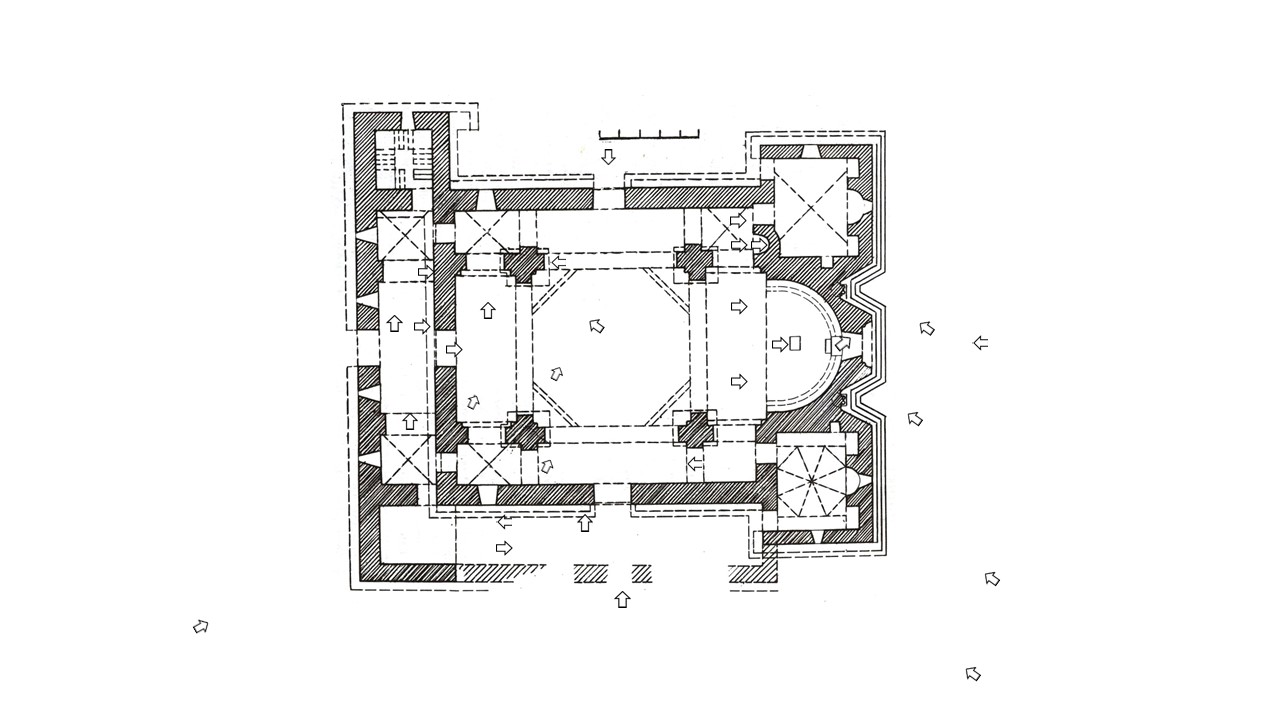Nato Chitishvili
The Church of the Ascension of Christ is located in the Kartli region, in the centre of the village of Tsromi. According to the inscription, which is located on the south wall of the church to the left of the central window, the church was built by Stephanos Vibatos:
Holy church have mercy on Stephanoz Vibatos
Stefanoz Vibatos was identified as Stephanoz II by Giorgi Chubinashvili, who studied and published the architecture of the church. Chubinashvili suggested that the church would have been constructed between 626-35.
According to the Life of Vakhtang Gorgasali, the first church on this spot was built in the 4th century, but nothing has remained from that period. In 457 a man named Rajden was martyred near this church. St Rajden the Protomartyr was a Persian nobleman in the court of King Vakhtang Gorgasali who converted to Christianity. Later, during the war of the Sassanids against Vakhtang Gorgasali, Rajden was executed by the Sassanid military. Shortly thereafter, the body of Rajden was translated to the episcopal church in Nikozi and was buried in that church.
Over the centuries the church of Tsromi has been damaged several times – in the 11th, 12th and 16th centuries. In an earthquake in 1940 the church, which was already in a poor condition, was damaged badly: the dome collapsed, as well as some parts of the vaults, cross-arms and parts of the walls. In the 1970s the church was restored and the new dome was erected.
Tsromi church heralded new developments in early medieval architecture. The architectural design of the church is distinguished for its balance and harmony. Together with Armenian churches of the same type, Tsromi is one of the earliest structures of the inscribed cross type. It has four free-standing piers supporting the dome and four arms branching off the central square bay. To the west, the church has a narthex with an upper gallery. The east façade of the church is articulated with two triangular niches, which play an important role in the design. In medieval Georgian architecture triangular niches were first applied at the church of Tsromi and after that they became an essential part of Georgian domed churches throughout the centuries.
In the interior of the church, namely to the left hand side of the door to the prosthesis, in the eastern wall of the church, there is a semicircular niche where a supplicatory inscription has survived. The inscription mentions St Rajden:
St. Rajden have mercy on […]
Based on the paleography, the inscription is dated to the 8th century and it seems the niche marked the place where St Rajden was martyred.
The apse of the church was covered with mosaics and frescos, both are contemporary with the church but the decoration has only partially survived and is in bad condition. In the conch there is a scene of Christ with two angels. Below the conch, in the centre, there is a painted image of the Virgin Mary and the apostles. According to Zaza Skhirtladze, who studied and published the mosaics and paintings of the church, “the mosaic and the fresco form a single, integral composition, in its concept. It reflects a Theophanic idea and is connected with the Ascension in its scheme”. On the walls flanking the central window there are three medallions: the central medallion shows the image of the cross and the other medallions show images of martyrs.
Interactive Plan

Image Gallery
Bibliography
- G. Chubinashvili, Tsromi (Moscow, 1969) (in Russian).
- Z. Skhirtladze, Tsromis Tadzris Istoriisatvis, Saqartvelos Metsnierebata Akademiis Matsne, N3, 1985, pp. 165-170 (in Georgian).
- Z. Skhirtladze, ‘Early Medieval Georgian Monumental Painting: Establishment of the System of Church Decoration’, Oriens Christianus, N81, 1997, pp. 171-174, Fig. 1, pp. 169-206.
- D. Khoshtaria, ‘An Outline of the Development of Church Architecture in Early Medieval Georgia’, in: S. Sasano, Y. Fujita, and M. Morita (eds), Historic Christian and Related Islamic Monuments in Eastern Anatolia and Syria (Tokyo, Saityu-sha, 2014), pp. 81-90.


